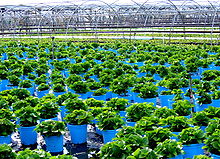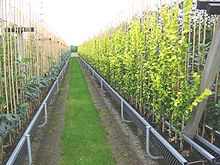- Plant nursery
-
For other uses of "Nursery", see Nursery (disambiguation).
A nursery is a place where plants are propagated and grown to usable size. They include retail nurseries which sell to the general public, wholesale nurseries which sell only to businesses such as other nurseries and to commercial gardeners, and private nurseries which supply the needs of institutions or private estates. Some retail and wholesale nurseries sell by mail.
Although the popular image of a nursery is that of a supplier of garden plants, the range of nursery functions is far wider than that, and is of vital importance to many branches of agriculture, forestry and conservation biology. Some nurseries specialize in one phase of the process: propagation, growing out, or retail sale; or in one type of plant: e.g., groundcovers, shade plants, or rock garden plants. Some produce bulk stock, whether seedlings or grafted, of particular varieties for purposes such as fruit trees for orchards, or timber trees for forestry. Some produce stock seasonally, ready in springtime for export to colder regions where propagation could not have been started so early, or to regions where seasonal pests prevent profitable growing early in the season.
Methods
Nurseries often grow plants in a greenhouse, a building of glass or in plastic tunnels, designed to protect young plants from harsh weather (especially frost), while allowing access to light and ventilation. Modern greenhouses allow automated control of temperature, ventilation and light and semi-automated watering and feeding. Some also have fold-back roofs to allow "hardening-off" of plants without the need for manual transfer to outdoor beds.
Most nurseries remain highly labor-intensive. Although some processes have been mechanised and automated, others have not. It remains highly unlikely that all plants treated in the same way at the same time will arrive at the same condition together, so plant care requires observation, judgment and manual dexterity; selection for sale requires comparison and judgment. A UK nurseryman has estimated (in 2003) that manpower accounts for 70% of his production costs. The largest UK nurseries have moved to minimize labour costs by the use of computer controlled warehousing methods: plants are pallet allocated to a location and grown on there with little human intervention. Picking merely requires selection of a batch and manual quality control before dispatch. In other cases, a high loss rate during maturation is accepted for the reduction in detailed plant maintenance costs.
Business is highly seasonal, concentrated in spring and autumn. There is no guarantee that there will be demand for the product - this will be affected by temperature, drought, cheaper foreign competition, fashion, among other things.
Annuals are sold in trays (undivided containers with multiple plants), flats (trays with built-in cells), peat pots, or plastic pots. Perennials and woody plants are sold either in pots, bare-root or balled and burlapped and in a variety of sizes, from liners to mature trees. Balled and Burlap (B & B) trees are dug either by hand or by a loader that has a tree spade attachment on the front of the machine. Although container grown woody plants are becoming more and more popular due to the versatility, B & B is still widely used throughout the industry.
Plants may be propagated by seeds, but often desirable cultivars are propagated asexually by budding, grafting, layering, or other nursery techniques.
See also
Categories:- Horticulture and gardening
- Nurseries
Wikimedia Foundation. 2010.



